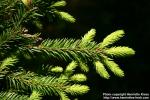Latin: Abies species, Picea species, Pinus species.
Family: Pinaceae, pine family.
Parts used: Young green growth ("shoots"), older greens, resin
Taste: Aromatic, bitter. Sweeter when young, sometimes almost lemony.
4 humors: Warm, Dry.
Actions:
- Great for coughs, in syrups, as a steam (to be inhaled), or applied, hot (not too hot though!), to the chest.
- Resin: excellent for various skin problems, in salves.
- Nice in foot baths; there, I'd strain out the spruce but leave the fir in. (Fir has much softer needles; spruce is spiky).
- A bath or liniment is nice for rheumatism and similar aches and pains. It gets the blood circulation going.
Food uses:
- Add the young shoots to beef and serve it as "moose".
- Bake salmon on a bed of sprigs and twigs. Note, don't leave any needles uncovered by the salmon. If you do, you'll have to hastily bring the burning smoking mess outside, hoping that the fire alarm won't go off and alarm your guests ...
Notes:
- Yes, the oils and resins of various conifers can be irritating to sensitive kidneys. If you get a lower back pain from eating too much fir (or spruce) shoot syrup, slow down on the conifers.
- Use any edible conifer the same way: pine works, too.
Experiences:
- A spruce shoot syrup, while great for coughs, doesn't last all that long around our house. Do make enough, so that there's something left when the coughing season arrives.
- A hot tea works as well as a liniment, for rubbing onto painful joints.
- The resin salve is absolutely top notch ... but I have found it easier to gather pine resin. Which works as nicely.
More on my site: Conifer twig syrup - Various herbal syrups - Various herbal oils..
Comments on Facebook:
http://www.facebook.com/note.php?note_id=332327043445400
- From Hilary M.:
Made an excellent spontaneous spruce tip and maple syrup beer a few years back! In fact, Just last night we made plans to make a grain based spruce tip beer. Its was a low-alcohol, sweet and refreshing spring beverage.
20 December 2011 at 17:48
Comments on the herblist:
http://lists.ibiblio.org/mailman/listinfo/herb
From dawn gates
Date: 2011 12 27 - 08:36:52 +0200I have used Fir for respitory complaints especially if they have thick sticky mucus with a dry hacking cough. I have also used the sap to cover wounds in a pinch (works great by the way) better then bandaids and neosporin combined.
From Sharon Hodges-Rust
Date: 2011 12 29 - 23:22:28 +0200The only thing I could think to say about pine or fir besides fire wood and xmas trees, is pine nuts which are alot of work so have been eaten rarely from the wild, even the sugar cone pine which has very big cones bigger and more nuts, the critters compete pretty strongly, so are doubly rare finds. my brother and I would, when we were kids, chew the pith of pine sticks like gum, it was more like chewing on cork than gum but the springy texture allowed us to chew on it for a length of time.
From Josh M.
Date: 2011 12 27 - 11:39:28 +0200I used to drink a lot of pine and spruce needle tea, but now have desire for it for whatever reason. Perhaps it served its purpose for me. I found the teas very refreshing and stimulating for a while, but eventually a bit harsh.
In any event, I found spruce needles to very effective in unplugging congested sinal and nasal cavities - sort of imagining the spiraled needles entered the cavities and 'uncorking' or 'unscrewing' the congestion. Pine needles seemed more effective at relieving chest congestion - imagine the long needles penetrating the depths of the respiratory system.
From Terri H.
Date: 2011 12 27 - 16:14:02 +0200Just a quick shout out...
I love to make herbal honeys
I am not an herbalist per se, I just know what I like
Fresh young tender tips of handsome Douglas Fir or other evergreen, fill a jar with them, but not crammed in. Then fill with honey, flip the jar when I walk by it, allow it to infuse even forever. I have made this with honeysuckle flowers too which made an awesome syrup, from the moisture in the flowers. I consider all of these respiratory medicine, not to as well as just delicious! :) I will also nibble tender evergreen tips such as the fir which has its tartness. I understand it has Vitamin C, not to fail to mention just the vitality of these trees!
Of course using other herbs such as rosemary, basil,and the like. I do not heat the honey, though others do recommend to gently heat to 120F. Never have had mold or anything else and have done this for decades.
From Kat M.
Date: 2011 12 27 - 18:48:12 +0200I used to make a strong pine/fir needle decoction and add it to the bath - wonderfully relaxing and soothing to the muscles. But it leaves a resin goo rim that is a little difficult to get rid off so I have switched to using essential oil of pine instead. It is not quite the same though.
Pine/fir honey as described by someone else earlier is also a fine thing, but I don't have much occasion for it.
From elaine mcdaniel
Date: 2011 12 29 - 16:19:30 +0200Kat,
I am amazed at what coconut oil will dissolve --- I got some tar on my hand and arm. The person I was with went straight to the chemicals they sell at the paint store to break it down. I grabbed some coconut oil and had the tar off in half the time his chemicals did --- might be worth a try -- instead of giving up on something that works! coconut oil worked well on removing oil based paint too.From Kat M.
Date: 2011 12 29 - 20:41:56 +0200Thanks for reminding me Elaine! You are absolutely right. I have used coconut oil as a kind of hand wash when I was blending incense professionally and was caked in resins, herbs and oils almost permanently.
Coconut oil did the trick every time! Trick is not to get water on first.
So, in a bathtub I guess one would have to let things dry off first.
Juniper thread:
From Meredith W.
Date: 2011 12 29 - 20:00:32 +0200We have lots and lots of Eastern Red Cedar here. Is it used the same as a conifer and what about the blue seeds (or berries?) on them?
From Henriette Kress
Date: 2011 12 29 - 20:35:26 +0200Eastern Red Cedar = Juniperus virginiana (that is, NOT a cedar.)
The greens of various edible Juniperus species can be used the same way, but ours are exceedingly spiky.
The berry is different, although you can make a cough syrup from that, too, if you like.
From Sharon Hodges-Rust
Date: 2011 12 29 - 23:22:28 +0200I could comment on juniper, using the berries for UTI only rarely but it worksed, occasionally for sore throats . And using a couple of sticks in the steam water to flavor tamales and to hold the plate out of the water. Gives slight flavor notes to the masa.
From Sharon Hodges-Rust
Date: 2011 12 30 - 00:38:15 +0200Ripe berries for tea and when out walking will chew on the fresh berries. i know the are warnings about juniper berries possibly harming kidneys, but i met an old woman in Utah who had been using it since childhood. Her mom was a madam of one of the houses, any how she got a UTI that turned into kidney infection and the docs were not able to get it cleared up the infections kept coming back and they recommended removing one of her kidneys. Well her mom decided to try juniper instead and it worked so she took it over the years when ever an infection loomed. When I met her she was 80 had diabetes and was looking for maybe something else to use cuz the juniper wasnt working as well and she ended up on antibiotics. Well she had an incredible stand of hollyhocks she was actually going to weed them out because they were taking over so, one of my recommendations was using the hollyhock roots and to use some of the uva ursi leaves also growing on the edge of her yard, as a tea, maybe in conjunction with the juniper or alone. Worked for her, dietary recommendation fell pretty much on dead ears... But she did consider no sugar use when she had an active infection. Since then I have used it a few times, but most of the time I am treating pregnant moms so dont use the juniper and rarely use uva ursi. Mostly blueberries and cranberries, marshmallow root or common mallow leaf.
Please add your own experiences etc. in the comments!
And remember to make a foot bath from the best twigs of your christmas tree, when it's time to throw it out! (If you got a tree, and it was a real one, that is.)



